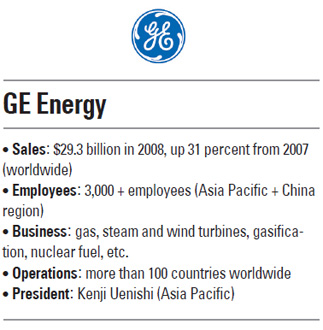Weaving success out of the wind

Kenji Uenishi
Uenishi, who comes to Korea about once every quarter, emphasized the importance of the Korean market and the development of “green” technologies during a one-on-one interview with the JoongAng Daily last week that followed his speech at this year’s World Knowledge Forum. The speech, titled “Wind Energy: Wind Changes Energy Map,” focused on wind energy as the most realistic renewable energy source - one that does not require a long lead time to pay off nor is dependent on geography.
“Korea is a key strategic market for us. We’ve been in business for over 100 years here and have strong ties with customers including Kepco [Korea Electric Power Corporation],” he said.
Following are excerpts from the interview.

A. Globally, gas turbines. In recent years, renewable energy has been a big part of our business. Wind power, smart grids and reduction of carbon emissions is very important to us. In the Asia Pacific region, we have a strong commitment to wind power, particularly in Australia. Also, we have smart grid and smart meter businesses in Australia, Japan and Korea.
How has business been in Korea, especially in the aftermath of the global economic slowdown?
Our business has not been affected too much. Korea has been impacted less than other countries in Asia due to strong companies like Samsung and LG. We see faster stabilization here, although some large scale new IPPs [independent power projects] have been delayed by three to six months. In terms of sales, the Asia Pacific region has shown healthy growth.
Where does the Asia Pacific region stand in terms of investments in renewable energy compared to other regions around the world?
When thinking of renewable energy in Asia, there is a strong nuclear presence in countries including Taiwan, Korea and Japan. There is also a strong push for hydro energy in Asia while Korea is showing a strong drive to develop solar power.
What are the strengths of wind power, compared to other alternative energy sources?
Solar and wind power are the two biggest alternative energy sources in development at this point. Because wind power development is more mature than solar power, it is cheaper. The wind energy market is growing not only in Europe and the U.S. but in Asia as well.
Wind power is especially good for countries like Korea, where most energy sources, including coal, come from outside the country, because the country can generate it with the appropriate technology and facilities.
Has the Korean government been active enough in energy security and renewable energy development compared to other Asian countries?
The most important factor in “green” energy development is policy. We have big hopes for this region. Growth is coming from Southeast Asia, especially from countries like Indonesia.
It is encouraging to see the Korean government strive to implement relevant policies. The Korean president’s renewable portfolio standard obligating utility companies to produce 3 percent of their electricity from renewable sources, is great news.
Australia is very active. They have the 20/20 policy [a policy that aims to generate 20 percent of total power from renewable energy sources by 2020]. It is also one of the most advanced in smart grid development. In New Zealand, there is a commitment to hydro energy while in Japan, there is significant growth in hybrid car sales.
What kinds of renewable energy sources will be the most profitable in the future?
If we categorize non-CO2 generating energy sources as renewable energy, nuclear energy has a large capacity for profitability. There is a strong nuclear presence in countries including Taiwan, Korea and Japan. I believe within five years, solar energy will be as big as wind power. IGCC [Integrated Gasification Combined Cycle] gasification will be important in the U.S. and Europe, which have coal.
What are the company’s plans for the Asia Pacific region this year?
In Korea, Taiwan and Japan, although GDP growth may not be large, we expect to see steady growth in installations. Korea is such an important country for us because many of the large companies we work with are Korean, including Hyundai Heavy, Samsung, Daewoo, Daerim, SK and Posco. We grow with these companies - Hyundai Heavy is in Kuwait, Doosan Heavy’s wind power business is in the Middle East.
By Cho Jae-eun [jainnie@joongang.co.kr]










with the Korea JoongAng Daily
To write comments, please log in to one of the accounts.
Standards Board Policy (0/250자)